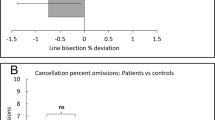Abstract
Hemispatial neglect due to right parieto-temporo-frontal lesions has a negative impact on the success of rehabilitation, resulting in poor functional gain. Recent research has shown that different types of neglect can impact in a different way on rehabilitation outcomes. The availability of a sensitive test, useful for distinguishing egocentric and allocentric forms of neglect, may be clinically important as all current clinical instruments fail to distinguish between these forms of disturbance, yet they differentially predict outcome. The Apples Test is a new instrument useful to evaluate both egocentric and allocentric forms of neglect. In order to establish Italian norms for this diagnostic instrument the test was administered to a sample of 412 healthy people of both genders (201 M and 211 F), aged from 20 to 80 years enrolled from 14 different rehabilitation centers in Italy. Based on the data, we established pathological performance cut-offs for the accuracy score (total omission errors), the asymmetry score for egocentric neglect (omission error difference), the asymmetry score for allocentric neglect (commission error difference) and execution time. The usefulness of the Apples Test for diagnostic purposes is illustrated by presenting three patients with different forms of neglect (egocentric, allocentric and mixed neglect).





Similar content being viewed by others
References
Jehkonen M, Ahonen JP, Dastidar P, Koivisto AM, Laippala P, Vilkki J, Molnar G (2000) Visual neglect as a predictor of functional outcome one year after stroke. Acta Neurol Scand 101(3):195–201
Paolucci S, Antonucci G, Grasso MG, Pizzamiglio L (2001) The role of unilateral spatial neglect in rehabilitation of right brain-damaged ischaemic strple patients: a matched comparison. Arch Phys Med Rehab 82:743–749
Nijober TCW, Kollen BJ, Kwakkel G (2013) Time course of visuospatial neglect early after stroke: a longitudinal cohort study. Cortex 49:2021–2027
Bowen A, McKenna K, Tallis RC (1999) Reasons for variability in the reported rate of occurrence of unilateral spatial neglect after stroke. Stroke 30:1196–1202
Milner DA, McIntosh RD (2005) The neurological basis of visual neglect. Curr Opin Neurol 18:748–753
Bartolomeo P (2007) Visual neglect. Curr Opin Neurol 20:381–386
Chechlacz M, Rotshtein P, Roberts KL, Bickerton W-L, Lau JKL, Humphreys GW (2012) The prognosis of allocentric and egocentric neglect: evidence from clinical scans. PLoS One 7(11):e47821. doi:10.1371/journal.pone.0047821
Grimsen C, Hildebrandt H, Fahle M (2008) Dissociation of egocentric and allocentric coding of space in visual search after right middle cerebral artery stroke. Neuropsychologia 46:902–914
Ota H, Fujii T, Suzuki K, Fukatsu R, Yamadori A (2001) Dissociation of body centered and stimulus centered representation in unilateral neglect. Neurology 57:2064–2069
Rorden C, Hjaltason H, Fillmore P, Fridriksson J, Kjartansson O, Magnusdottir S, Karnath HO (2012) Allocentric neglect strongly associated with egocentric neglect. Neuropsychologia 50:1151–1157
Yue Y, Song W, Huo S, Wang M (2012) Study on the occurrence and neural bases of hemispatial neglect with different reference frames. Arch Phys Med Rehabil 93:156–162
Stone SP, Wilson B, Wroot A, Halligan PW, Lange LS, Marshall JC, Greenwood RJ (1991) The assessment of visuo-spatial neglect after acute stroke. J Neurol Neurosurg Psychiat 54:345–350
Bickerton WL, Samson D, Williamson J, Humphreys GW (2011) Separating forms of neglect using the Apple Test: validation and functional predicting in chronic and acute stroke. Neuropsychology 25:567–580
Wilson B, Cockburn J, Halligan P (1987) Development of a behavioural test of visuospatial neglect. Arch Phys Med Rehabil 68:98–102
Humphreys G, Bickerton WL, Samson D, Riddoch M (2012) BCoS cognition screen. Psychology Press, Hove
Oldfield RC (1971) The assessment and analysis of handedness: the Edinburgh inventory. Neuropsychologia 9:97–113
Magni E, Binetti G, Bianchetti R, Rozzini R, Trabucchi M (1996) Mini-Mental State Examination: a normative study in Italian elderly population. Eur J Neurol 3:198–202
Bamford J, Sandercock P, Dennis M, Warlow C, Burn J (1991) Classification and natural history of clinically identifiable subtypes of cerebral infarction. The Lancet 337:1521–1526
Collin C, Wade DT (1990) Assessing motor impairment after stroke: a pilot reliability study. J Neurol Neurosurg Psychiat 53:576–579
Denes G, Semenza C, Stoppa E, Lis A (1982) Unilateral spatial neglect and recovery from hemiplegia a follow-up study. Brain 105(3):543–552
Chechlacz M, Rotshtein P, Bickerton WL, Hansen PC, Deb S, Humphreys GW (2010) Separating neural correlates of allocentric and egocentric neglect: distinct cortical sites and common white matter disconnections. Cogn Neuropsychol 27:277–303
Medina J, Kannan V, Pawlak MA, Kleinman JT, Newhart M, Davis C, Heidler-Gary JE, Herskovits EH, Hillis AE (2009) Neural substrates of visuospatial processing in distinct reference frames: evidence from unilateral spatial neglect. J Cogn Neurosci 21:2073–2084
Acknowledgments
We would like to especially thank M. Pacini, B. Basagni, E. Todeschini, R. Moretti, S. Prestigiacomo, M.A. D’angelo, A. Lazzarini, C. Zucchella, M.E. Girò, F. Cellamare, E.Conti, M. Marchetti and G. Alla for their contribution in collecting the data.
Conflict of interest
The authors declare that they have no conflicts of interest.
Author information
Authors and Affiliations
Corresponding author
Electronic supplementary material
Below is the link to the electronic supplementary material.
Appendix
Appendix
See Table 2.
Rights and permissions
About this article
Cite this article
Mancuso, M., Rosadoni, S., Capitani, D. et al. Italian standardization of the Apples Cancellation Test. Neurol Sci 36, 1233–1240 (2015). https://doi.org/10.1007/s10072-015-2088-2
Received:
Accepted:
Published:
Issue Date:
DOI: https://doi.org/10.1007/s10072-015-2088-2




